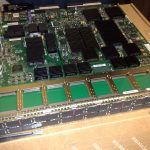 The 10 Gigabit Ethernet (10GE) standard was ratified in 2002, but we finally only got around to installing our first 10GE interface last year. This year, we have another big bunch of 10GE links interconnecting a big bunch of our switches. 10GE still costs a bomb. The Cisco 16-port 10GE line card lists for something like S$80K. Yes, that’s a big sum of money, particularly since the line card on its own is not very useful: You still need a chassis, power supply, fan tray, and supervisor module at the very least.
The 10 Gigabit Ethernet (10GE) standard was ratified in 2002, but we finally only got around to installing our first 10GE interface last year. This year, we have another big bunch of 10GE links interconnecting a big bunch of our switches. 10GE still costs a bomb. The Cisco 16-port 10GE line card lists for something like S$80K. Yes, that’s a big sum of money, particularly since the line card on its own is not very useful: You still need a chassis, power supply, fan tray, and supervisor module at the very least.
The nice thing about networking in the last decade is that everything has basically settled down around the Ethernet standard. Everything. Even Wireless LAN is basically Ethernet. Ethernet has also crept its way into Wide Area Network applications. It has simplified things for network professionals. (Actually it has made things simple enough that everyone could say they knew how to setup and run networks.)
But while everything is standardizing on Ethernet, the networking devices have become more and more complicated. There are so many things to learn and to know.
Our Catalyst 6509, for example, has been running the 8-port 10GE line card just fine. But the new 16-port 10GE line card wouldn’t come up, because it is apparently unsupported by our current firmware. Yeah, an oversight on our part not to check on the firmware requirements first. I suppose this is not too different from how some PC motherboards require a BIOS firmware update to support a new CPU. The firmware for a Catalyst 6509 is more complicated, of course. I’m always a bit apprehensive about upgrading, partly because we don’t have the luxury of a testbed to test the firmware, and the switches we’re upgrading are always “critical”.
The firmware upgrade this time around had a few surprises, but fortunately nothing as spectacular as many others we’ve been through. Someday, Cisco should think about how to make firmware upgrades for their products as idiot proof as, say, their Linksys products.
View Comment Policy